A team may boast of a magnificent bowling attack in terms of skill but it takes an equally magnificent wicketkeeper to make it look good otherwise runs will be leaked on a regular basis to the opposition. Just as in soccer when the defense of a team is made to look good by an outstanding goalkeeper who stops the opposition from scoring goals. This piece celebrates those wicketkeepers who have sacrificed pleasures for good fitness levels and won matches for their country with their wicketkeeper as well as batting skills.
1) Adam Gilchrist (Australia)
Gilly will easily enter into an all-time XI as he is undoubtedly the No.1 wicketkeeper batter in the history of the game. There are others in this category but Adam Gilchrist comes first because he had to bear the rigours of ODIs, Tests and T-20s to an extent and despite making a relatively late debut in international cricket, he was able to achieve a world record of catches and stumpings combined in the final stages of his career.
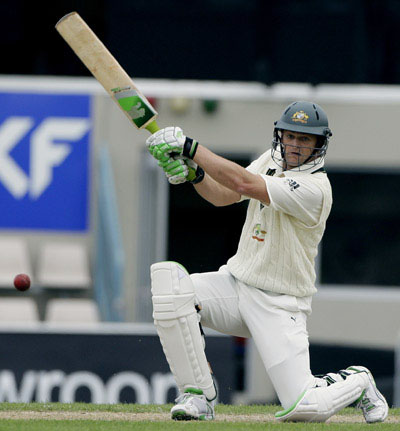
As a wicketkeeper, according to the legendary Ian Healy, Adam Gilchrist was his ideal successor as he had one of the finest techniques in his generation. Rarely did one see him drop catches or miss stumpings and that is because of a sharp eye which was the fruit of amazing concentration. He thrived in all conditions and types of bowlers, plus the fact that to keep to the likes of Glenn McGrath who had a terrific amount of movement in his bowling, Brett Lee with his deadly pace and above all Shane Warne who was the spin king was an acid test but Gilly passed with flying colours.
While as a batsman, Adam Gilchrist is a top-hand player so his hand-eye co-ordination is impeccable as he threads the ball into gaps or goes over the top for sixes. This made him dangerous especially in the ODIs as he opened the batting for Australia for the majority of his career and formed a lethal partnership with the burly Matthew Hayden at the top. A brilliant 149 in the 2007 World Cup final against Sri Lanka at Barbados is a perfect example of his ability to innovate as well by using a squash ball in his glove to generate more power in his shots, as he was out of form throughout the whole tournament.
In Tests, Adam Gilchrist has the most number of sixes by any player in the history of the game. He also possesses the world record for the second fastest century in Tests, which was against England at Perth in 2006. No team could ever feel at ease until he was there at the crease, being the last yet extremely recognized batter in the line-up.
However, he will never be forgotten for his sportsmanship when he walked himself after being given not out in the World Cup semifinal in 2003 and the fact that he is the first Australian skipper to win a Test series in India since 1969. Now he plays in the IPL for Kings XI Punjab as their captain too and in the minds of the Indian fans, he will remain a ‘demi-god’ after inspiring a lowly Deccan Chargers to an IPL championship win in 2009 and the fairness with which he approaches the game.
2) Ian Healy (Australia)
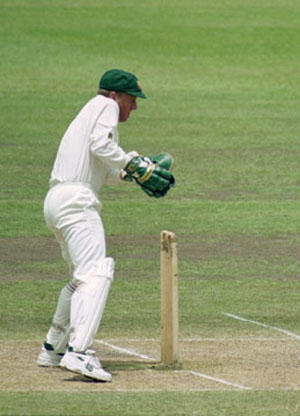
Ian Healy laid the foundations for Gilchrist’s and Australia’s success after retiring in 1999 gracefully. It showed that he was a team player, who wanted the best for his nation when he realized that he was aged and not the same wicketkeeper to don the gloves for Australia again. But when he was at his prime, it was his skills which helped Australia turn the tables around when it came to world dominance and it was in his time that the team began to build a stronghold in cricket, with West Indies on the decline.
He made an unheralded entry into international cricket in 1988 after having played just six first-class matches. However, it was his work ethic which the Aussies needed desperately when they were performing poorly. Shane Warne was ascending at the time Healy kept to him, and so due credit must be given to him for his glorious glove work to the leg-spinner which Gilchrist watched closely and learnt from. By the time he finished, he had the world record in his name with 395 Test dismissals which were precisely 366 catches and 29 stumpings. Aptly, it was Gilly who broke that record 7-8 years later.
As a batsman, Ian Healy was a useful player to have down the order in Tests in case the batters had an odd day but that was rare so he never had to work on his batting as such and just contribute as per the situation. But in ODIs, he had a strike rate of 83.8 and an average of 22 which meant that he could hit the ball hard and score quickly. While he could never be his country’s captain, he always considered himself as a potential vice-captain and preferred focusing on his game rather than strategies which was again humble of him since he knew his standing for the country
Now he is a noted commentator on Channel Nine and sometimes goes around the world to train budding cricketers about the art of wicket keeping, as a service for the game.
3) Mark Boucher (South Africa)
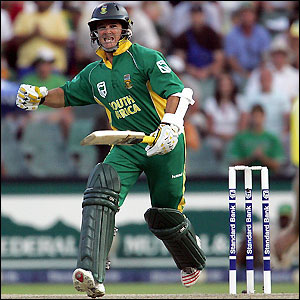
Mark Boucher took over Gilchrist’s record of the most Test dismissals in 2008, establishing himself as one of the greatest wicketkeepers of all time alongside Healy. In the contemporary era of T-20s gaining popularity, Boucher will be the last of the classical wicketkeepers to have taken by the field by the time he calls it a day and which he is likely to, in the next 18 months.
He was initially tentative in wicket keeping in swinging conditions such as those in England and his frailties were exposed in the 1998 tour there in which the Proteans lost the Test series. However, he has a great temperament and determination to succeed and he worked harder as ever to improve his keeping skills even as his other teammates would look to get off the field after a tiring work out or skip optional practice sessions. His desire to keep improving will make him hold the world record possesses perhaps forever in Tests as no other keeper these days has the skills he has at the moment.
Mark Boucher is a relentless competitor and aggressive and that is seen in his batting as well. In Tests he has an average of 30.20 which is impressive for a No.7 batsman while in ODIS, it is a strike rate of 84.76 which is eye-catching. He famously guided South Africa home in the 2006 ODI at Joburg against Australia in a world record chase of 434. He also has one of the fastest ODI centuries of all time, scoring a hundred in just 44 balls against Zimbabwe in 2006.
Currently, Mark Boucher is struggling to get back his place in the ODI team with AB de Villiers likely to continue wicket keeping even if he has been made captain. While in Tests too he is under some pressure to perform with age and batting form not on his side and several wicketkeepers in line to succeed him. Yet, he will remain one of the finest wicketkeeper-bats to have graced the cricket field and not only South African, but world cricket will felicitate his achievements some day.
4) Jeff Dujon (West Indies)
Jeff Dujon is perhaps one of the boldest wicket-keeper batters to have ever played the game, if not the greatest.
Jeff Dujon may not be publicized about much, but in the era of the 80s he was the best of the lot as he had to keep to the likes of Michael Holding, Joel Garner, Malcolm Marshall and Andy Roberts who had nothing but pace and bounce in their deliveries with a partisan Caribbean crowd behind them.
He could not be judged unfortunately when it comes to keeping to spin bowling as West Indies did not have a dearth of slow bowlers in those days, so he never got an opportunity to prove himself.
He was only exceeded by Ian Healy and Rod Marsh in his keeping achievements later on, so he had a record 272 dismissals when he quit the game. Batting-wise, Dujon was said to be an elegant yet patient and he scored five Test hundreds as a result with one of them coming in the first Test of the marquee Australia series in 1984-85 at the WACA at Perth, which is still the fastest pitch in the world and rescued his team from a precarious 186 for 6 in the first innings.
He played for a decade until 1991 and now he too is a TV commentator as he is seen these days in matches featuring the West Indies.
5) Rod Marsh (Australia)
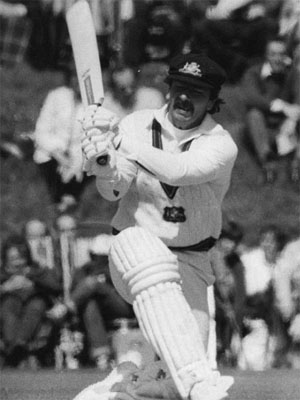
An energetic character, Rod Marsh had a Test career spanning from the 1971 to the 1984. In 96 Tests, he set a world record of 355 wicket keeping dismissals; the same number his pace bowling Western Australian team-mate Dennis Lillee achieved with the ball. The pair was known for their bowler-wicketkeeper partnership, which yielded 95 Test wickets, a record for any such combination, and made their debuts and retired together. Wisden stated that “Few partnerships between bowler and wicket-keeper have had so profound an impact on the game.
Rod Marsh had a controversial start to his Test career, selected on account of his batting abilities. The Australian media criticized Marsh’s glove work, dubbing him “Iron Gloves” after sloppy catching in his debut Test. His keeping improved over time and by the end of his career he was regarded as one of the finest in the history of the sport. He was widely regarded for his sense of team discipline, in particular after Bill Lawry controversially declared the Australian first innings closed in the Fifth Test of the 1970–71 series at the MCG with Marsh just eight runs short of a century.
Powerfully built, Marsh was regarded as an all rounder for the majority of his career. Coupled with his short stature, his power suited him to the task of keeping wicket. Despite his bulk, which forced him to work heavily on reducing his weight in his early career, he had fast feet movement, combined with fast anticipation and reflexes which allowed him to cover more ground. He raised the role of wicketkeeper to a more prominent status in a team with his acrobatic diving, raucous appeals and habit of throwing a ball high into the air upon completing a dismissal. As the wicketkeeper, he made himself the focal point in the field and attempted to extract higher standards of concentration from both himself and his team-mates.
Over the years he has worked at the Centre of Excellence in Brisbane which enriches the talent Australia possesses and famously called Ricky Ponting as the finest teenage batsman he had ever seen play, rightly predicting a great future for him.
6) Jack Russell (England)
Wicketkeepers are often eccentric, but Jack Russell out quirks the lot. Whether he is standing up to the medium-pacers, barking encouragement to his fielders or leaving the ball with a gratuitous flourish, Russell was the character’s character.
As a keeper he was quick-witted and quick-handed, if sometimes untidy. He was very much like his mentor Alan Knott, who was perhaps the first man to promote the importance of wicket keeping in the English team in his playing days.
Russell would end at close to 200 Test dismissals in his career.
As a No.7 batsman he was unorthodox but resolute – his unbeaten 29 in 277 minutes at Johannesburg in 1995-96 is often forgotten.
And also he has the highest score of 128 not out which shows that he can bat if required. England messed him about though, often preferring Alec Stewart for the sake of balance in the team and that abruptly ended his career.
Now he is a famous artist and remains a tea-addict, due to which he can sometimes make headlines in British newspapers.
7) Alec Stewart (England)
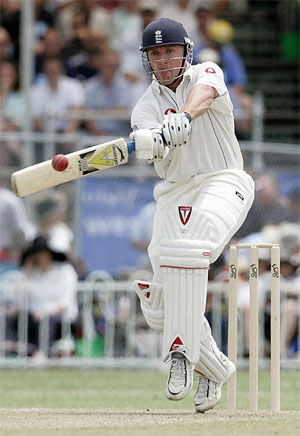
When Stewart was in his elements, there were few who could live with him. Depending more on timing rather than placement, he was in complete control against the quicks, cover-driving with a neat flourish and pulling with panache – most memorably when he smashed two hundreds in Barbados in 1993-94. He was tentative though against the slow bowlers, and his inert style of batting meant his career was a see-saw. Alec Stewart was more of a batsman than a wicketkeeper and he could open the batting too. As a result, Jack Russell was toyed around with by the English selectors in the 90s and their job was made easier when Russell retired and by that point, Stewart had enhanced his skills enough to become the first choice wicket-keeper batsman of the country.
He took over the England captaincy from Mike Atherton in 1998 and promptly led the side to its first major series win for 12 years, against South Africa. But Stewart’s leadership was more instinctive rather than logical, and so when England were humiliated in yet another Ashes series and produced a flop-show as hosts in the 1999 World Cup, he was unceremoniously dumped as captain.
Alec Stewart continued though for four more years and in his final Test, England incidentally beat South Africa at The Oval in 2003. He ended with 277 dismissals in Tests, a national record and 174 of them in ODIs. As of runs, Stewart scored 8463 of them in Tests which is extremely incredible for a wicketkeeper bat whose position was played around with in the team and in ODIs, he has scored 4677 runs at a good average of 31.60.
8) MS Dhoni (India)
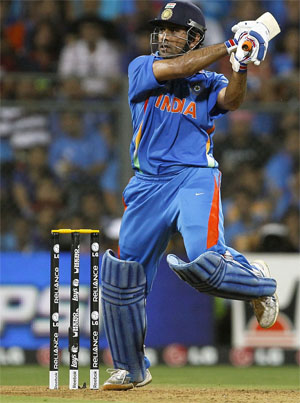
MS Dhoni will always be recognized as the second World Cup winning skipper for India after Kapil Dev. His winning six in that final against Sri Lanka will remain etched in the minds of every Indian fan for years to come. Although he is still playing and had a rough few months post-World Cup, Dhoni has already achieved so much for his nation being a captain, wicketkeeper and batsman.
He made his debut in December 2004 against Bangladesh in ODIs, and was already a hit for his long hair and his hard-hitting ability. Some magnificent ODI knocks such as an unbeaten 183 against Sri Lanka in 2005 hastened his Test debut against the same team a few weeks later. Initially as a wicketkeeper, Dhoni was far from polished but like other legendary keepers, he kept learning how to get better and better at it.
His rise co-incided with him being appointed captain for the T-20 World Cup in South Africa in 2007 and he found instant success by leading the team to the title. There was no looking back for him as he went on not only change his style of wicket keeping but also his batting, to be a shrewd finisher for his side in the ODIs and not just an instinctive hitter which explains why he has a batting average of 51.15 in this format and a strike rate of 88.52 as of now.
In Tests as well, MS Dhoni may not have the technique but has improved his temperament to bat and that has been seen with an average of 37.98, which is decent for a No.7 batsman. Overall, he has 460 dismissals, 202 of them in Tests and 258 of them in ODIs, breaking the record of Syed Kirmani and establishing himself as the No.1 wicketkeeper batter of India of all-time.
MS Dhoni may have a few years of international cricket left in him due to the exhausting schedule the Indians have these days, which includes the IPL where he also leads the Chennai Super Kings. So it is hard to rate him as an all-time great in the world as yet, but he has huge ability of being one.
9) Kumar Sangakkara (Sri Lanka)
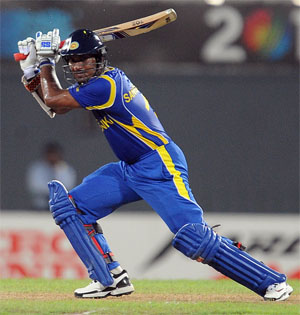
If Dhoni is India’s pride as a wicketkeeper batsman, Sangakkara is the same for Sri Lanka. Fittingly it was these two gentlemen who led their sides in the World Cup 2011 final in Mumbai. Anyway, the greatest aspect about Sanga is the fact that he is the premier batsman of Sri Lanka in all formats of the game and still manages to keep in ODIs and T20s since his needs him to, in order to achieve the ideal balance that they want.
He ended with 186 Test dismissals as wicketkeeper before giving up the responsibility to a better keeper in Prasanna Jayawardene. As a result, he has now become one of the top batsmen in Test cricket at the moment, with an amazing series against Pakistan in the UAE when he singlehandedly led the batting ship. But this is not the case in ODIs as wicket keeping has not affected his batting as such and as a result, he has been able to keep a check on his fitness levels which make him available for Sri Lanka on a regular basis.
A double of close to 10000 ODI runs and nearing 400 ODI dismissals is not far away from him and this will make one of the finest wicket-keeper batsmen to have ever played international cricket. He is never given due credit for his achievements due to his nationality.
As captain of the national side, Sangakkara was impressive as he led Sri Lanka to the World T-20 final in 2009 and the World Cup 2011 final. And in Tests, it was under him that Sri Lanka last won a home Test which was against India at Galle in 2010 and it was their only Test win for the next 18 months as it was only a week back that Sri Lanka beat South Africa at Durban.
He won accolades for his opinion on sledging and a few months back for his eloquent MCC Spirit of Cricket Lecture where he bravely spoke out about the callous Sri Lankan cricket administrators ruining the country’s future in the game and some of the rules of cricket. He will always remain a true gentleman, something which cricketers are rarely these days.
10) Andy Flower (Zimbabwe)
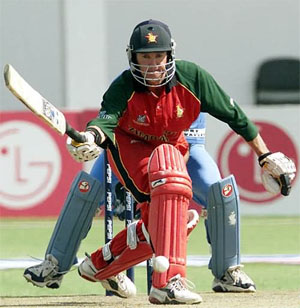
Currently England’s coach, Flower will always be considered as one of the glorious wicketkeeper batsmen to have played the game especially due to the fact that he flourished playing for a minnow team such as Zimbabwe.
He had two stints as the captain of his country, leading them to their first Test victory against Pakistan in 1994-95, and then becoming the first Zimbabwean to lead a Test tour of England, in 2000. He did not have much of success as leader and so focused on his batting which was his key strength as his wicket keeping skills deteriorated. Traditionally he was better at playing the fast bowlers but gradually evolved to become one of the finest players of spin bowling in the world in his era as he also became flexible to bat anywhere in the top or middle order. The point is proved with his outstanding aggregate of 540 runs during the tour of India in late 2000 despite the team losing the Test series.
He then became the target for opposition bowlers and after a phenomenal Test against South Africa at Harare, when he made 142 and 199 not out, he suffered a rare rough patch. He announced his retirement from international cricket after a turbulent 2003 World Cup, which started with an unprecedented protest by Flower, and his equally brave team-mate Henry Olonga, as they both infamously wore black armbands signifying the death of democracy in Zimbabwe due to the dictatorship of President Robert Mugabe.
As wicket-keeper, Flower was average and sometimes scratchy which is why he was advise to quit keeping in the latter half of his career and concentrate solely on his batting. However, he had a total of 333 dismissals in his name counting both Tests and ODIs making him the greatest Zimbabwean wicketkeeper-bat in the history of the game.

Leave a Reply